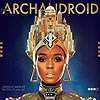Best Of 2010: Janelle Monáe, The ArchAndroid
Published on December 16th, 2010 in: Best Of Lists, Current Faves, Music, Music Reviews, Reviews |By Brenna Chase

There’s no need for a list. Devote all of your listening attention to Janelle Monáe’s The ArchAndroid. It was conceived by a twentysomething theatre major from Kansas, executive-produced by Sean “Diddy” Combs and Outkast’s “Big Boi” along with members of Monáe’s own creative outfit, The Wondaland Arts Society, and released on Bad Boy Records. If this seems a bit of a random selection, know that nothing about this album is typical.
The ArchAndroid is the epitome of risk and eccentricity. It’s a schizophrenic experience of genres, moods, characters, and themes. And, I promise you, it’s the only concept album released in 2010 that truly matters.
The concept goes like this: Janelle Monáe recorded The ArchAndroid back in 1954 when she was a patient in the Palace of the Dogs Arts Asylum for “mutants, lost geniuses, and servants.” Just this year, the Vice Chancellor of the institution found the songs and released them to the public.
The music tells of Metropolis, a futuristic world set in 2719 ruled by the suppressive Great Divide, where expression of emotion and free will is prohibited and eradicated by time travel. Cindi Mayweather, the messianic ArchAndroid and supposed clone from Janelle’s DNA, has committed the worst sin of all: fallen in love with a human, Anthony Greendown. She struggles to follow her destiny and free her android society from the Great Divide, all the while professing her pure love and passion for her forbidden fleshy soulmate. And this myth may not be a myth at all—it’s possible these discovered songs are a firsthand time-traveled account of Cindi’s life as an android before she was forcibly sent to the future for her crimes, and Metropolis may very well be the civilization ours has yet to become. Or something like that.
If you can’t grasp all of this yet, don’t worry; keep listening.
The ArchAndroid is more than an album, it’s an “emotion picture” (Janelle’s own description), and there’s a lot to take in. Its 18 songs contain tasteful collisions of soul, hip hop, glam, spoken word, psychedelia, rock & roll (e.g., guitarist Kellindo’s Hendrix-meets-intergalactic Charlie Christian riffs), funk, R&B, jazz (walking bass lines, classy brass!), choral, opera, classical, samba, and Afrofuturism (look it up). Orchestral interludes and samples of Debussy are interwoven with guest spots by Saul Williams, Big Boi, and Of Montreal, not unlike the structure of a film score.
In one verse, Monáe spits references to Noah’s Ark, the Sudanese, and the Congolese, while in another she rhymes “Wondaland” with “underpants,” then later name checks Harriet Tubman and John Henry. On top of it all, Monáe assumes no less than ten different characters within each song and modifies her voice to match each personality—she’s a yearning, crooning lover; a mechanical robot lyricist; a crazed prisoner in an asylum. On paper, The ArchAndroid may seem like an overly ambitious mess. But its eclectic, complex production is arranged meticulously into a coherent pop album.
Like much of the most esteemed art, Janelle Monáe’s music alludes to compositions that came before her. Her stylistic predecessors (James Brown, Ziggy Stardust, Michael Jackson, Frank L. Baum, Walt Disney, Stevie Wonder, Lauryn Hill, Shakespeare, George Orwell, Sun Ra, Tommy James and the Shondells, Simon and Garfunkel, and Prince, to name a few) come through loud and clear throughout The ArchAndroid‘s different narratives.
When you buy the album, which I very much insist you do, spring for the $10 PHYSICAL copy. The liner notes alone are worth having on hand; they include Janelle’s inspiration behind each track, e.g., “Locked Inside” is “inspired by the collage in Stevie Wonder’s mirrored sunglasses (see the Music of My Mind LP).”
And like all timeless artists, Monáe adds an extra magic something to the best of what’s been done before and transforms it into an entirely new creation. The ArchAndroid is infused with derivative elements of all her heroes, yet every song belongs unmistakably to Janelle Monáe.
The ArchAndroid is Janelle Monáe’s full-length debut (it’s actually Suites II and III of a four part series; the complete emotion-picture experience begins with the Part I Metropolis: The Chase EP, released in 2008). Think about it. This is like The Beatles introducing themselves to the world on Ed Sullivan with Sgt Pepper’s or the B-side of Abbey Road. Monáe has already earned three Grammy nominations so far: Best Urban/Alternative Performance for the The Chase Suite EP’s “Many Moons” in 2009; Best Contemporary R&B Album (The ArchAndroid); and Best Urban/Alternative Performance (“Tightrope”) this year. She has nothing in common with any of successful artists in today’s mainstream pop culture, yet she’s already a star. And her music constructs an entirely new, stylized world born from her own imagination.
It is impossible to sufficiently describe why and how this album is good; I would much rather be listening to it right now than attempting to write this. And there are greater messages and comments on history and society and love underlying the songs, but I’ll let you uncover those on your own. Just know that The ArchAndroid is the opposite of anything boring (i.e., other 2010 concept albums that shall remain nameless). And Part IV is yet to come.
For now, we’re left to wonder what will happen to Cindi Mayweather and what emotion-pictures Janelle Monáe has yet to unveil. Imagine the possibilities…
The ArchAndroid was released on May 18, 2010. For more on Janelle Monáe, please check out her website. And if you’re still not sure you’re into any of this, see her perform live . . . you’ll get it.
Time limit is exhausted. Please reload the CAPTCHA.